| Question.11 You are developing a model to predict events by using classification. You have a confusion matrix for the model scored on test data as shown in the following exhibit. 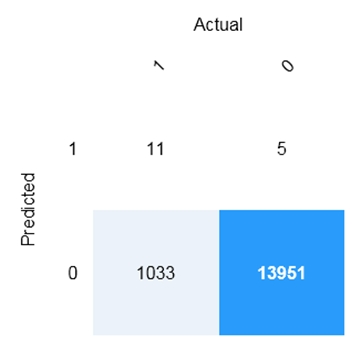 Select the answers choice that completes each statement based on the information presented in the graphic. 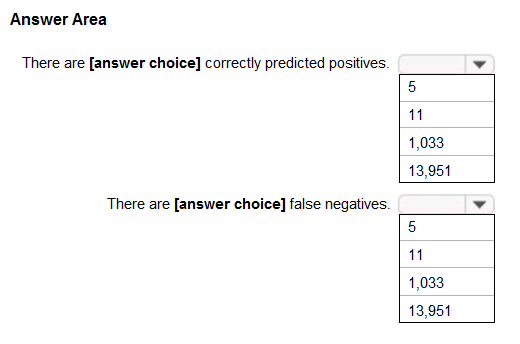 |
11. Click here to View Answer
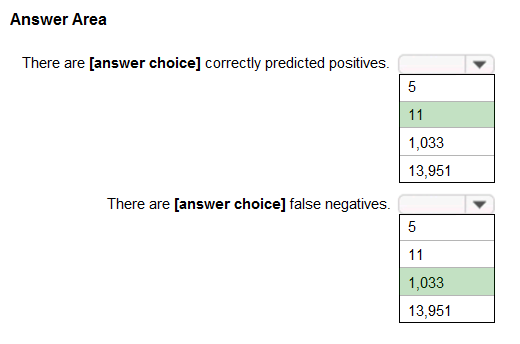
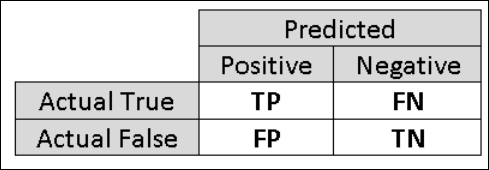
TP = True Positive.
The class labels in the training set can take on only two possible values, which we usually refer to as positive or negative. The positive and negative instances that a classifier predicts correctly are called true positives (TP) and true negatives (TN), respectively. Similarly, the incorrectly classified instances are called false positives (FP) and false negatives (FN).
Box 2: 1,033
FN = False Negative
Reference:
https://docs.microsoft.com/en-us/azure/machine-learning/studio/evaluate-model-performance
| Question.12 You build a machine learning model by using the automated machine learning user interface (UI). You need to ensure that the model meets the Microsoft transparency principle for responsible AI. What should you do? (A) Set Validation type to Auto. (B) Enable Explain best model. (C) Set Primary metric to accuracy. (D) Set Max concurrent iterations to 0. |
12. Click here to View Answer
Answer is (B) Enable Explain best model.
MS AI responsibilities
• Fairness – Limit Biases
• Reliability ad Safely – ops, resist manipulating, use of regresses testing
• Privacy and security- secure data provide security controls
• Inclusiveness- AI available to everyone i.e., disabled ppl
• Transparency- fully aware of the limitations over AII in use
• Accountability- follow governments and frameworks meet legal and ethical standards
Most businesses run on trust and being able to open the ML “black box” helps build transparency and trust. In heavily regulated industries like healthcare and banking, it is critical to comply with regulations and best practices. One key aspect of this is understanding the relationship between input variables (features) and model output. Knowing both the magnitude and direction of the impact each feature (feature importance) has on the predicted value helps better understand and explain the model. With model explain ability, we enable you to understand feature importance as part of automated ML runs.
| Question.13 For each of the following statements, select Yes if the statement is true. Otherwise, select No. 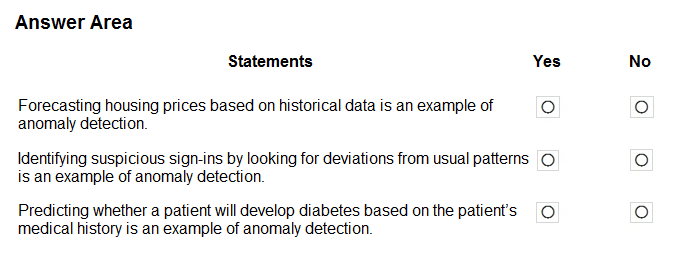 |
13. Click here to View Answer
Answer is N/Y/N (regression, anomaly, classification)
Reference:
https://learn.microsoft.com/en-us/azure/cognitive-services/anomaly-detector/overview
| Question.14 DRAG DROP Match the services to the appropriate descriptions. To answer, drag the appropriate service from the column on the left to its description on the right. Each service may be used once, more than once, or not at all. You may need to drag the split bar between panes or scroll to view content. NOTE: Each correct selection is worth one point.  |
14. Click here to View Answer
Answer:

| Question.15 Which service should you use to extract text, key/value pairs, and table data automatically from scanned documents? (A) Custom Vision (B) Face (C) Form Recognizer (D) Language |
15. Click here to View Answer
Answer: C
Form Recognizer applies advanced machine learning to accurately extract text, key-value pairs, tables, and structures from documents.
Reference:
https://azure.microsoft.com/en-us/services/form-recognizer/
| Question.16 DRAG DROP You plan to deploy an Azure Machine Learning model by using the Machine Learning designer. Which four actions should you perform in sequence? To answer, move the appropriate actions from the list of actions to the answer area and arrange them in the correct order. 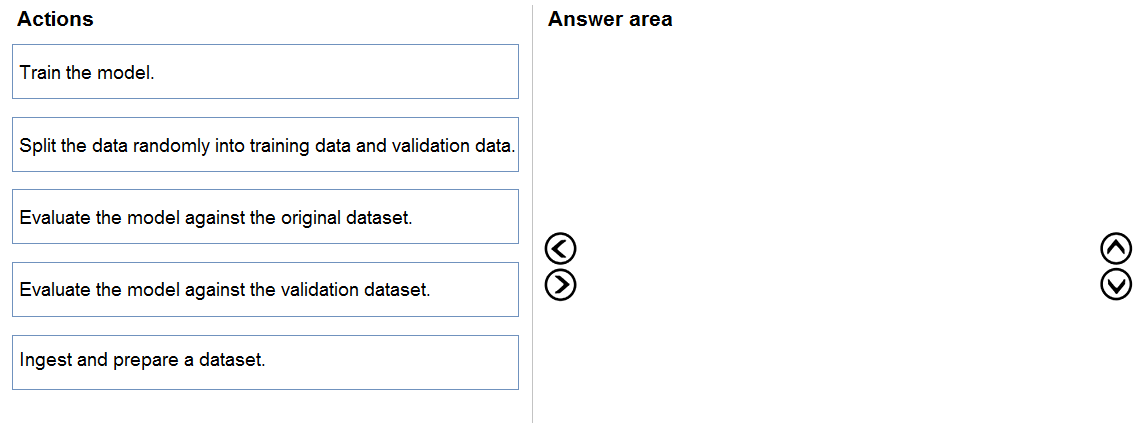 |
16. Click here to View Answer
Answer:
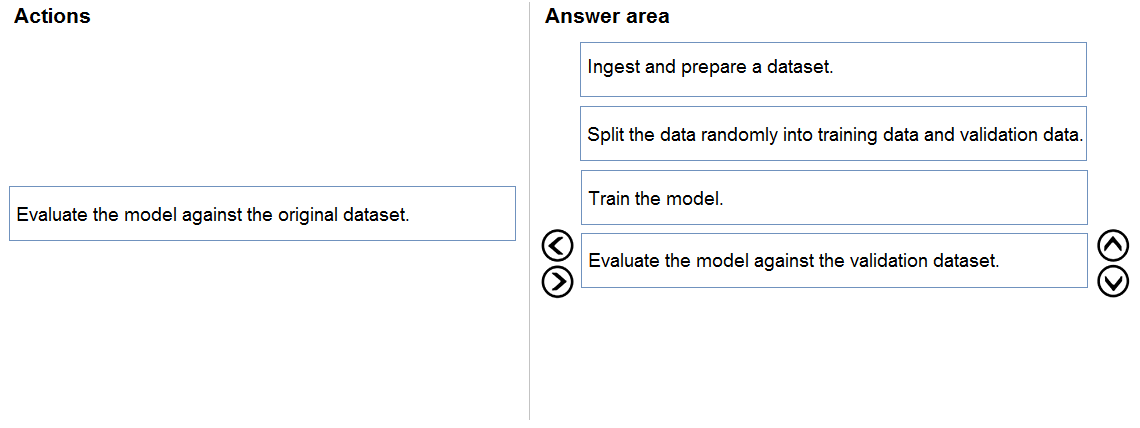
| Question.17 You are processing photos of runners in a race. You need to read the numbers on the runners’ shirts to identity the runners in the photos. Which type of computer vision should you use? (A) facial recognition (B) optical character recognition (OCR) (C) image classification (D) object detection |
17. Click here to View Answer
Answer: B
Optical character recognition (OCR) allows you to extract printed or handwritten text from images and documents.
Reference:
https://docs.microsoft.com/en-us/azure/cognitive-services/computer-vision/overview-ocr
| Question.18 DRAG DROP You plan to use Azure Cognitive Services to develop a voice controlled personal assistant app. Match the Azure Cognitive Services to the appropriate tasks. To answer, drag the appropriate service from the column on the left to its description on the right. Each service may be used once, more than once, or not at all. NOTE: Each correct selection is worth one point. Select and Place:  |
18. Click here to View Answer
Answer:

Box 1: Speech –
The Speech service provides speech-to-text and text-to-speech capabilities with an Azure Speech resource. You can transcribe speech to text with high accuracy, produce natural-sounding text-to-speech voices, translate spoken audio, and use speaker recognition during conversations.
Box 2: Language service –
Build applications with conversational language understanding, a Cognitive Service for Language feature that understands natural language to interpret user goals and extracts key information from conversational phrases. Create multilingual, customizable intent classification and entity extraction models for your domain- specific keywords or phrases across 96 languages.
Box 3: Speech –
Incorrect:
Not Translator text: Text translation is a cloud-based REST API feature of the Translator service that uses neural machine translation technology to enable quick and accurate source-to-target text translation in real time across all supported languages.
Reference:
https://docs.microsoft.com/en-us/azure/cognitive-services/speech-service/overview https://azure.microsoft.com/en-us/services/cognitive-services/conversational-language-understanding/ https://docs.microsoft.com/en-us/azure/cognitive-services/translator/text-translation-overview
| Question.19 You need to identify groups of rows with similar numeric values in a dataset. Which type of machine learning should you use? (A) clustering (B) regression (C) classification (D) None Of These |
19. Click here to View Answer
Answer: A
| Question.20 HOTSPOT You have an app that identifies birds in images. The app performs the following tasks: Identifies the location of the birds in the image Identifies the species of the birds in the image Which type of computer vision does each task use? To answer, select the appropriate options in the answer area. NOTE: Each correct selection is worth one point. 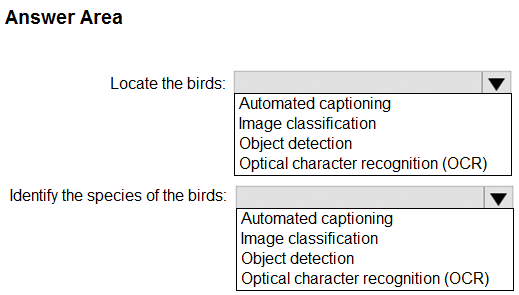 |
20. Click here to View Answer
Answer:

